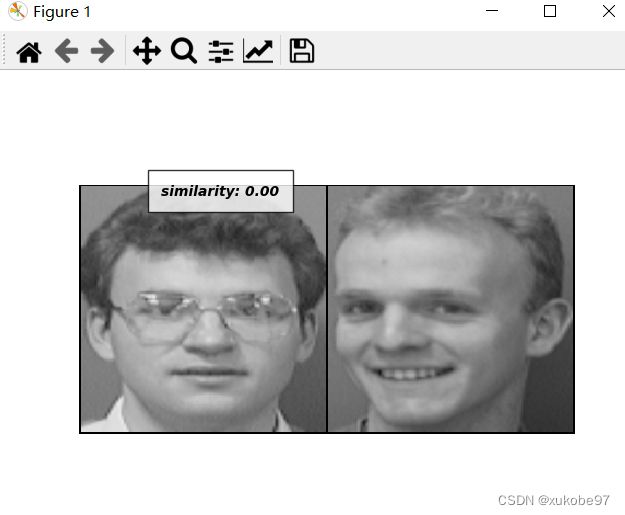pytorch搭建孪生网络比较人脸相似性
参考文献:
神经网络学习小记录52——Pytorch搭建孪生神经网络(Siamese network)比较图片相似性_Bubbliiiing的博客-CSDN博客_神经网络图片相似性
Python - 深度学习系列2-人脸比对 Siamese_yukai08008的博客-CSDN博客
1.孪生网络
孪生神经网络(Siamese network)即“连体的神经网络”,
神经网络的“连体”是通过共享权值来实现的,如图所示。
孪生神经网络有两个输入(Input1 and Input2),利用特征提取网络将输入映射到新的空间,形成输入在新的空间中的表示。然后对得到的两个输出进行相减,得到新的输出,并进行全连接层分类,最后输出一个向量,再通过Sigmoid函数将其转化到0-1之间,该值即为两个输入的相似度。
2.孪生网络
(1)特征提取部分
本孪生网络采用vgg16的features作为特征提取网络,提取完后将两个向量展平,便于相减得到新的向量并进行全连接层分类。
代码实现:
vgg16 = models.vgg16(pretrained=True)
# 获取VGG16的特征提取层
vgg = vgg16.features
class SiameseNetwork(nn.Module):
def __init__(self, input_shape):
super(SiameseNetwork, self).__init__()
self.vgg = vgg
def forward_once(self, x):
output = self.vgg(x)
output = torch.flatten(output, 1)
def forward(self, input1, input2):
output1 = self.forward_once(input1)
output2 = self.forward_once(input2)
这里最好不要将features的权重冻结,因为这样不能很好提取我们所需图片的特征,泛化能力也不好。
(2)全连接层
将得到的两个输出(output1和output2)进行相减,得到output,并对output进行全连接层,注意:其展平长度需通过计算得出,最后通过三个全连接层得到一个输出通道,并采取Sigmoid将其范围控制在0到1之间。(由于我们使用的损失函数是BCEWithLogitsLoss,即进行损失计算前会对预测值进行Sigmoid,因此在这里我们就不加Sigmoid)
代码实现:
def get_img_output_length(width, height):
def get_output_length(input_length):
# input_length += 6
filter_sizes = [2, 2, 2, 2, 2]
padding = [0, 0, 0, 0, 0]
stride = 2
for i in range(5):
input_length = (input_length + 2 * padding[i] - filter_sizes[i]) // stride + 1
return input_length
return get_output_length(width) * get_output_length(height)
class SiameseNetwork(nn.Module):
def __init__(self, input_shape):
super(SiameseNetwork, self).__init__()
flat_shape = 512 * get_img_output_length(input_shape[1], input_shape[0])
# flat_shape = 1000
self.fc = nn.Sequential(
nn.Linear(flat_shape, 512),
nn.ReLU(inplace=True),
nn.Linear(512, 256),
nn.ReLU(inplace=True),
nn.Linear(256, 1))
def forward(self, input1, input2):
output = output1 - output2
output = self.fc(output)
# output = nn.Sigmoid(output)
return output3.标签的生成
对于相似的图片,我们标签为1;对于不同的图片,我们将标签设置为0
代码实现:
class SiameseNetworkDataset(Dataset):
def __init__(self, imageFolderDataset, transform=None, should_invert=True):
self.imageFolderDataset = imageFolderDataset
self.transform = transform
self.should_invert = should_invert
def __getitem__(self, index):
img0_tuple = random.choice(self.imageFolderDataset.imgs)
# we need to make sure approx 50% of images are in the same class
should_get_same_class = random.randint(0, 1)
if should_get_same_class:
while True:
# keep looping till the same class image is found
img1_tuple = random.choice(self.imageFolderDataset.imgs)
if img0_tuple[1] == img1_tuple[1]:
break
else:
while True:
# keep looping till a different class image is found
img1_tuple = random.choice(self.imageFolderDataset.imgs)
if img0_tuple[1] != img1_tuple[1]:
break
img0 = Image.open(img0_tuple[0])
img1 = Image.open(img1_tuple[0])
img0 = img0.convert("RGB")
img1 = img1.convert("RGB")
if self.should_invert:
img0 = PIL.ImageOps.invert(img0)
img1 = PIL.ImageOps.invert(img1)
if self.transform is not None:
img0 = self.transform(img0)
img1 = self.transform(img1)
return img0, img1, torch.from_numpy(np.array([int(img1_tuple[1] == img0_tuple[1])], dtype=np.float32))
def __len__(self):
return len(self.imageFolderDataset.imgs)
4.损失函数和优化器
criterion = torch.nn.BCEWithLogitsLoss()
optimizer = torch.optim.Adam(net.parameters(), 0.001, betas=(0.9, 0.999))5.训练过程
(1)参数设置:
training_dir = r"D:\Siamese_for_Face\data\faces\training"
train_batch_size = 16
train_number_epochs = 200
input_shape = [224, 224](2)数据集加载
transform = transforms.Compose([transforms.Resize((224, 224)),
transforms.ToTensor()])
folder_dataset = dset.ImageFolder(root=training_dir)
siamese_dataset = SiameseNetworkDataset(imageFolderDataset=folder_dataset,
transform=transform,
should_invert=False)
train_dataloader = DataLoader(siamese_dataset,
shuffle=True,
num_workers=0,
batch_size=train_batch_size)(3)网络的加载并移到GPU训练
net = SiameseNetwork(input_shape)
device = torch.device("cuda:0" if torch.cuda.is_available() else "cpu")
net.to(device)(4)训练循环
counter = []
loss_history = []
iteration_number = 0
if __name__ == '__main__':
for epoch in range(0, train_number_epochs):
for i, data in enumerate(train_dataloader, 0):
img0, img1, label = data
img0, img1, label = img0.to(device), img1.to(device), label.to(device)
optimizer.zero_grad()
output = net(img0, img1)
loss_contrastive = criterion(output, label)
loss_contrastive.backward()
optimizer.step()
if i % 10 == 0:
print("Epoch number {}\n Current loss {}\n".format(epoch, loss_contrastive.item()))
iteration_number += 10
counter.append(iteration_number)
loss_history.append(loss_contrastive.item())
plt.plot(counter, loss_history)
plt.show()
torch.save(net.state_dict(), 'weights/vgg.pkl')
6.测试过程
(1)展示图片
def imshow(img, text=None, should_save=False):
npimg = img.numpy()
plt.axis("off")
if text:
plt.text(75, 8, text, style='italic', fontweight='bold',
bbox={'facecolor': 'white', 'alpha': 0.8, 'pad': 10})
plt.imshow(np.transpose(npimg, (1, 2, 0)))
plt.show()(2)参数设置
testing_dir = r"D:\Siamese_for_Face\data\faces\testing"
input_shape = [224, 224](3)加载数据集
testing_dir = r"D:\Siamese_for_Face\data\faces\testing"
input_shape = [224, 224]
transform = transforms.Compose([transforms.Resize((224, 224)),
transforms.ToTensor()])
folder_dataset_test = dset.ImageFolder(testing_dir)
siamese_dataset = SiameseNetworkDataset(imageFolderDataset=folder_dataset_test,
transform=transform,
should_invert=False)
test_dataloader = DataLoader(siamese_dataset, num_workers=0, batch_size=1, shuffle=True)(4)加载网络和训练过的权重
net = SiameseNetwork(input_shape)
device = torch.device("cuda:0" if torch.cuda.is_available() else "cpu")
net.to(device)
net.load_state_dict(torch.load(r'D:\Siamese_for_Face\weights\vgg.pkl'))(5)测试过程
if __name__ == '__main__':
dataiter = iter(test_dataloader)
x0, _, _ = next(dataiter)
for i in range(10):
_, x1, label2 = next(dataiter)
x0, x1, label2 = x0.to(device), x1.to(device), label2.to(device)
concatenated = torch.cat((x0, x1), 0)
# output1, output2 = net(Variable(x0), Variable(x1))
output = net(Variable(x0), Variable(x1))[0]
output = torch.nn.Sigmoid()(output)
# euclidean_distance = F.pairwise_distance(output1, output2)
imshow(torchvision.utils.make_grid(concatenated).cpu(),
'similarity: {:.2f}'.format(output.item()))7.网络的效果
这里我是设置了0.0005的学习率和400个epochs
感觉最后训练的效果很好,说明vgg16网络的features的特征提取能力很强大,这里要注意的是,不要设置太大的学习率,因为我们这是迁移学习,主要是利用vgg16特征提取的权重,设置太大的学习会将原本训练好的vgg16的权重扭曲太多。
8.代码
(1)gitee
Siamese_for_Face.zip · xuxuxuxu/xuxuxuxu - 码云 - 开源中国 (gitee.com)
(2)github
xuxuxuxu/Siamese_for_Face.zip at main · xuxuxuxuxuxu97/xuxuxuxu (github.com)


